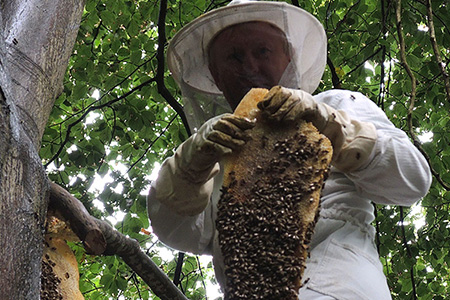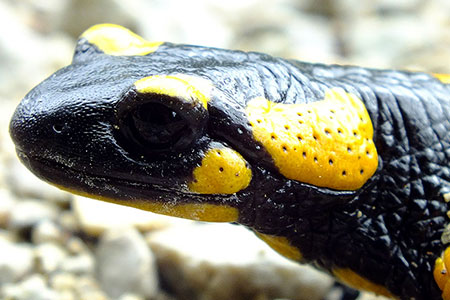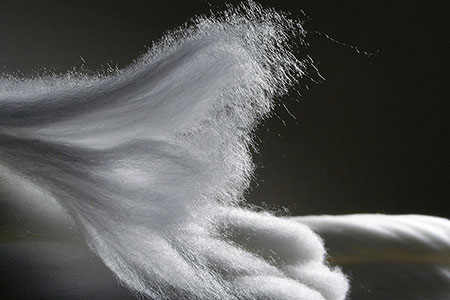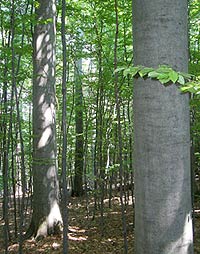
Hordelymo-Fagetum - one of the best sites
European Beech (Fagus sylvatica) – Portrait of a Tree Species
European beech may well reach an age of 300 years and, in rare cases, even 500 years. Also, it may reach over 40 m in height. The figures of the Austrian Forest Inventory of 2000/2000 show that the percentage of European beech in industrial timber production is 9,6 %. Thus, beech is by far the most important species in the production forest.
According to the German Federal Forest Inventory 2 the average growing stock per hectare for European beech is 352 m3, ranking third behind spruce (404 m3/ha) and fir (480 m3/ha). The growth performance of European beech reaches up to 70 %, in comparison to spruce. The volumetric yield of over 700 m3 per hectare is hardly exceeded.
Occurrence
Stands dominated by beech are located between 150 and 1500 m a.s.l. in the "Northern Limestone Alps" and at 1550 m a.s.l. in the "Southern Alps". Beech is dominating and co-dominating in beech forest communities, spruce-fir-beech forests and common maple-beech forests. In other forest communities, beech is mixed in varying degree.
Due to its status as climax species, beech has a wide range of sites (Figure 1). Silvicultural decisions in the past and as well as current decisions have contributed to the fact that beech has lost a considerable part of its former distribution area. The natural distribution of beech in Europe has long been subject to discussions due to uncertainty about the degree of anthropogenic introduction spreading (British Islands, Northern Europe).
Distribution patterns of European beech
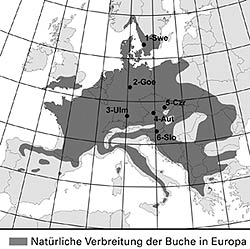
Natural distribution of beech in Europe (dark-grey). Marked are the sites of the SUSTMAN project.
European beech grows under a wide range of climate conditions. According to some authors, mild, atlantic climate conditions without extreme temperatures are favourable to the growth of European beech. Various authors indicate 500 mm as the minimum annual precipitation for Germany, 600 mm for Austria and 750 mm for France. Studies conducted in Bavaria (Felbermayer 1994) report that even precipitation quantities of only 500 mm would not affect beech growth.
Temperature demands of beech are much higher than those of fir (Abies alba). The duration of the vegetation period should be five months, according to Mayer (1980). Other authors indicate an even shorter period. In Austria, beech-dominated or co-dominated stands can be found on sites up to an annual temperature sum of 2150°C; this corresponds to a mean annual temperature of 5,5°C. In Bavaria, Felbermayer (1994) found beech-dominated stands on sites with mean annual temperatures between 4,0 and 9,5°C. Beech growth is best on sites with higher temperatures, although competition between trees appears to play a major role.
Wagenitz (1981) describes the sharp limit of beech occurrence in Eastern Prussia which is due to "continental" climate (late frost, annual mean temperature). Many regional studies show that the occurrence of European beech depends on a combination of climate factors (e.g. late frost, daily maximum temperature, drought periods, continental climate), local edaphic parameters (buffer capacity, cation exchange capacity, base saturation) and soil hydrological parameters as well as anthropogenic factors.
Site evaluation
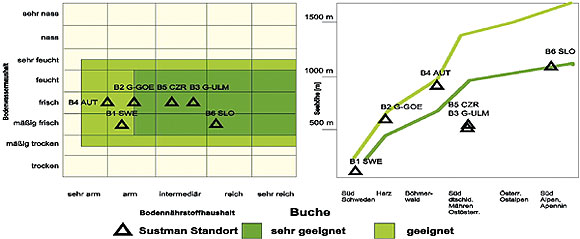
Figure 2: Ecogram for European beech based on soil water and soil nutrient budget as well as altitude; The SUSTMAN research sites in Southern Sweden (B1-SWE), in the Harz mountains (B2-GOE), near Ulm (B3-Ulm), near Weitra (B4-AUT), near Brünn (B5-CzR) and in the Bachern mountains (B6-SLO) are marked by triangles
The ecogram (Figure 2) is used for assessment studies related to the suitability of sites, it is based on the assessment of soil nutrient and water budgets including altitude. It also considers climate factors. The graphic representation is based on literature reports (e.g. Mayer 1980, Ellenberg 1963), but also on data generated by the EU Project SUSTMAN. The sites which have been subject to detailed investigation are located in Southern Sweden (abbreviated: B1-SWE), in the Harz mountains (B2-GOE), near Ulm (B3-Ulm), near Weitra (B4-AUT), near Brünn (B5-CzR) and in the Bachern mountains (B6-SLO).
The dark green area (highly suitable) marks those sites where a higher resource input seems to be justified und which are susceptible to produce high quality beech timber. The light green area marks those sites where the production of high quality timber is not likely and beech may only be grown for the purpose of preservation or rehabilitation of the site potential (reduction of business risk, increase of stand stability).
Depending on the site, beech is often replaced by spruce
Due to easier management and higher growth performance beech is often replaced on "highly suitable" sites by conifers such as spruce. Compared to beech, the share of timber is higher in spruce stands with a lower site dependent business risk.
On very moist to very wet sites (anmoor, gley soils, pseudogley soils) beech is developing flat roots being more prone to wind throw. Nevertheless, beech also grows on stagnic soils. Productivity is low on very dry sites.
Beech itself shows good growth behaviour, even on soils which are poor in nutrients (oligotrophic). Near its climatic optimum beech grows well on very acid soils (ph value around 3,0) with low base saturation (about 5 %), e.g. on sandy soils (Schleswig-Holstein) or on podsolic soils. This is shown by sites in Southern Sweden, in the Harz area and in Weitra: On these sites, base saturation is between 3 and 12 %, pH value is between 2,9 and 4,5 and magnesium saturation and potassium contents are very low. Soil types range from podsolic Cambisols to Podzols.
Red heart - a criterion for quality
If the sites are not in the range of the climatic optimum, then productivity decreases. As in beech red heart develops normally in the age 80 to 100 on sites with low productivity, the production of high value and quality timber is not possible. On these sites, besides the production of timber and fuel wood, the preservation of the site quality is a priority goal. In addition, non-forest benefits such as biodiversity and recreation are gaining in importance.
Nutrient poor sites (base saturation > 18 %, ph value > 4,2, sufficient supply with all nutrient elements) up to very nutrient rich sites are most suitable for beech growth. Literature studies have shown that nutrient demands increase in cooler climate zones and indifference towards acid soils is decreasing. The sites of B3-Ulm, B5-CzR and B6-SLO are considered to be highly suitable in terms of nutrient budget. Due to the altitudinal level the Slovenian plot in the Bachern mountains is not suited for the production of high quality timber. Additional risks which affect the performance of beech are frost (inversion condition, alpine basin), in particular late frost (bud damages) and winter frost (temperatures in January < 2,0°C).
Climate change scenarios
What would be the impact of climate change? Assuming currently discussed scenarios - a rise in temperature between 0,8 to 2,0°C as well as a decrease in precipitation by 10-15 % during the vegetation period – the potential distribution of beech in the mild climate of the Eastern part of Austria would hardly be affected. At the montane level, beech would clearly benefit from favourable growth conditions (Lexer et al. 2001). However, from this, it cannot be concluded that there will be a shift in tree species composition in this area, because it is difficult to assess both tree species competition under changed climate conditions and the resulting management decisions .

